How to Fix a Formula Parse Error in Google Sheets

A formula parse error in Google Sheets is usually a problem with how the formula is written or the data it uses. This guide explains how to fix it.
Google Sheets offers a huge collection of functions that can do everything from finding averages to translating text. Just don’t forget the concept of garbage in, garbage out. If you mess up somewhere in your formula, it’s not going to work properly. If that’s the case, you may get an error, but how do you fix a formula parse error in Google Sheets?
There are a number of different formula parse errors that you might see depending on exactly what is wrong with your formula. The way you can fix an error will depend on the type of error that you’re dealing with.
We’ll show you how to fix a formula parse error in Google Sheets using the steps below.
What is a Formula Parse Error in Google Sheets?
A formula parse error in Google Sheets occurs when the application is unable to process the instructions in your formula. This is often because there is either something wrong with the formula itself or something wrong with the cells that the formula is referencing.
There are a number of different types of formula parse errors in Google Sheets. The method to fix a formula parse error in Google Sheets will depend on the type of error that your formula produces.
We’ll take a look at some of the most common formula parse errors and how to fix them below.
How to Fix the #ERROR! Error in Google Sheets
The #ERROR! formula parse error occurs when Google Sheets cannot understand your formula but isn’t exactly sure where the problem lies. When you see a formula parse error in your spreadsheet, you can see more information about the error by hovering over the small red triangle in the top right-hand corner of the cell.
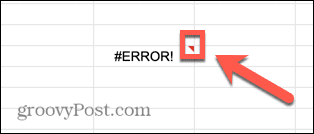

For many of the errors below, this will provide some useful information about the cause of the error. In the case of an #ERROR! formula parse error, this box provides nothing that we didn’t already know.
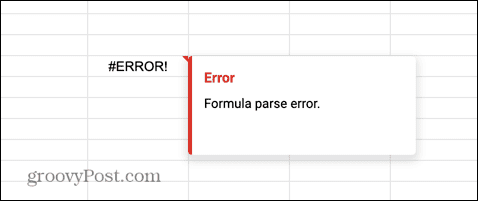

Unfortunately, #ERROR! is one of the hardest formula parse errors to fix. You’ll have very little to go on and the cause could be one of a number of different problems.
If your formula is complex, then finding the cause of an #ERROR! message can be challenging—but not impossible.
To fix the #ERROR! message in Google Sheets:
- Click the cell containing your formula.
- Work through the formula to check you’re not missing any operators. A missing + sign, for example, could cause this error.
- Check that the number of open brackets matches the number of closed brackets.
- Check that your cell references are correct. For example, a formula that uses A1 A5 instead of A1:A5 would produce this error.
- See if you have included the $ sign anywhere in your formula to refer to currency. This symbol is used for absolute references for cells, so could cause this error if used incorrectly.
- If you still can’t find the source of the error, try creating your formula again from scratch. Use the helper that appears when you start typing any formula in Google Sheets to ensure that your formula has the correct syntax.
How to Fix the #N/A Error in Google Sheets
The #N/A error occurs when a value or string that you are looking for is not found in the given range. This could be because you are looking for a value that isn’t in the list, or because you have entered the search key incorrectly.
This error is usually found when using functions such as VLOOKUP and HLOOKUP. The good news is that hovering over the red triangle will usually give you some useful information about how to solve the issue.
To fix the #N/A error in Google Sheets:
- Hover over the red triangle in the cell showing the error.

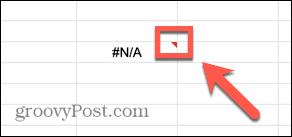
- You should see some information about the cause of the error.


- In this example, the formula is searching for the name ‘Alam’ but the correct spelling of the name in the list is ‘Alan’.


- Correct the spelling in the formula, and the error disappears.


- Other possible causes for the error could be that your data does not contain the search key you are looking for, or that you have entered the wrong range. Work back through your formula to ensure that each part is correct, and your error should be fixed.
How to Fix the #DIV/0! Error in Google Sheets
This error is one that is commonly seen when you are using formulas that involve mathematical division. The error indicates that you are trying to divide by zero. This is a calculation that Google Sheets cannot perform since, mathematically, the answer is undefined.
To fix the #DIV/0! error in Google Sheets:
- Click in the cell containing your error.
- Look for a division symbol (/) in your formula.
- Highlight the section to the right of this symbol and you should see a value pop up above the highlighted region. If this value is zero, the section that you have highlighted is the cause of the #DIV/0!

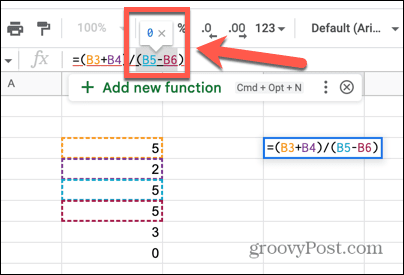
- Repeat for any other divisions within your formula.
- When you have found all of the instances of division by zero, changing or removing these sections should remove the error.
- You may also get this error when using functions that use division in their calculations, such as AVERAGE.
- This will usually mean that your selected range does not contain any values.

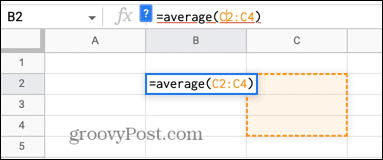
- Changing your range should fix the problem.
How to Fix the #REF! Error in Google Sheets
The #REF! error means that you have an invalid cell reference in your formula. This could be because you are referring to a cell that doesn’t exist, because you are referring to a cell outside the bounds of your selected range, or because you have a circular reference. Hovering over the red triangle will tell you which of these issues are causing your error.
Reference Does Not Exist #REF! error
When you hover over the error cell, you may see a message that the reference does not exist.
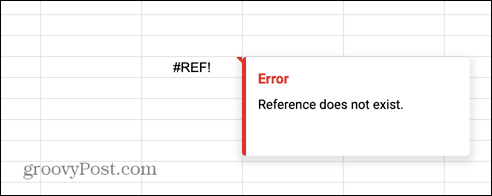

If you see this error, it means that at least one of the cells referenced in your formula no longer exists. This will often happen if you delete a row or column that contained cells that were being referenced in your formula.
To fix a reference that does not exist #REF! error:
- Click the cell containing the error.
- Look for #REF! within the formula itself.


- Replace this section of the formula with a value or valid cell reference.


- The error will now disappear.
Out of Bounds Range #REF! Error
If you hover over the cell containing the error, you may see a message that the formula evaluates to an out-of-bounds range.
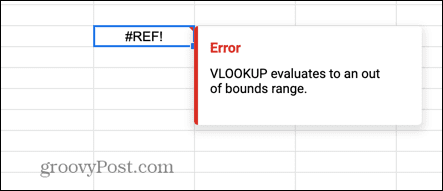

This means your formula is referring to cells that aren’t included in the range you specified.
To fix an Out of Bounds Range #REF! error:
- Click the cell containing your error.
- Examine the formula in that cell for any references to cells outside the range.

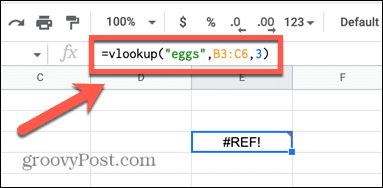
- In this example, the range refers to values in columns B and C but is asking the formula to return a value from the third column in the range. Since the range only contains two columns, the third column is out of bounds.
- Either increase the range to include three columns or change the index to 1 or 2, and the error will disappear.
Circular Dependency #REF! Error
Hovering over a #REF! error cell may reveal that the issue is due to a circular dependency.
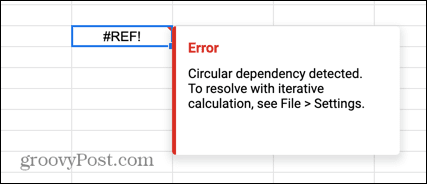

This means that the formula is trying to reference itself. This is a common error that can occur when you are trying to find the sum of a column of figures, and accidentally include the cell containing your formula in the range.
To fix a Circular Dependency #REF! error:
- Click the cell containing your error.
- Take note of the reference of this cell, such as B7.


- Look for this cell reference in your formula. The cell may not appear explicitly in your formula; it may be included in a range.

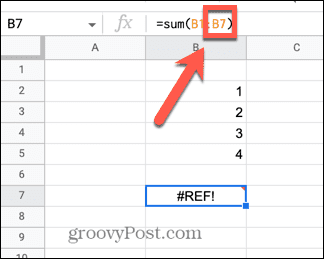
- Remove any reference to the cell containing the formula from the formula itself, and the error will disappear.

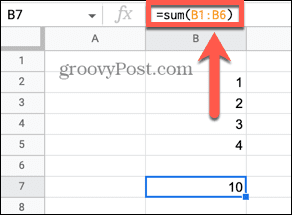
How to Fix the #VALUE! Error in Google Sheets
The #VALUE! error occurs when you are using a formula that requires a numerical value but is instead using or referencing cells that contain a text string. Hovering over the cell can provide very useful information about the exact cause of the problem.
To fix a #VALUE! error in Google Sheets:
- Hover over the cell containing the error.
- You will see information about which part of your formula is causing the error. If your cell contains any blank spaces, these may cause the cell to be treated as text rather than as a value.

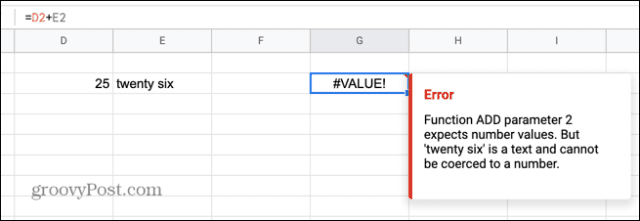
- Replace the offending section of your formula with a value or a reference to a value, and the error will disappear.


How to Fix the #NAME? Error in Google Sheets
The #NAME? error indicates that you have entered a spelling error in the formula, or that you have either omitted or used quotation marks incorrectly. Hovering over the cell can help you identify which part of the formula is incorrect.
To fix a #NAME? error in Google Sheets:
- Hover over the error cell.
- You’ll see information about which part of the formula is not recognized.

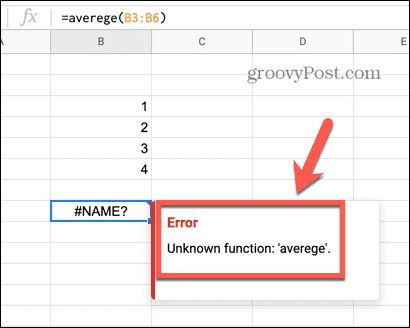
- If the word is obviously misspelled, correct the spelling and the error should disappear.

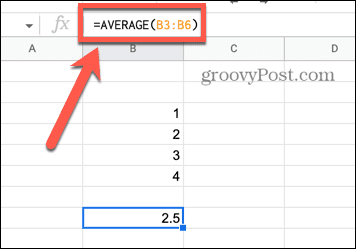
- If the word is spelled correctly, find the section of the formula that contains that word.

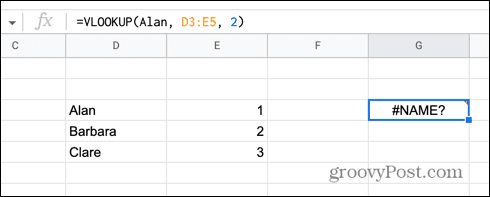
- Try adding or removing quotes around this word and the error message may disappear.


How to Fix the #NUM! Error in Google Sheets
The #NUM! error indicates that the value you are trying to calculate is beyond the ability of Google Sheets to calculate or display. Hovering over the cell can provide information about the cause.
To fix a #NUM! error in Google Sheets:
- Hover over the cell containing the error.
- If the result of your formula is too large to display, you will see a relevant error message. Reduce the size of your value to fix the error.


- If the result of your formula is too large to calculate, hovering over the cell may provide you with the maximum value that you can use in your formula.

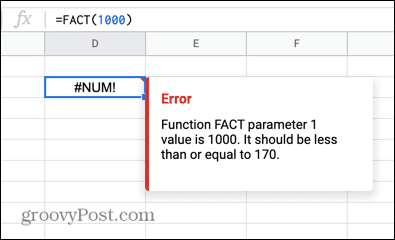
- Staying within this range will fix the error.

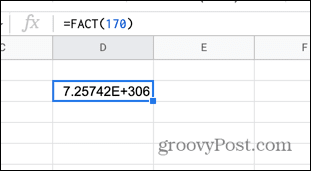
Unlock the Power of Google Sheets
Learning how to fix a formula parse error in Google Sheets means that you can solve problems with your formulas and get them working how you want them.
Once your formulas are fixed, there is an almost endless list of things you can use them for. You can calculate averages, sum columns, or alphabetize a list.
You can also use Google Sheets formulas to separate names, track your fitness goals, and even track stock performance.
Leave a Reply
Leave a Reply






